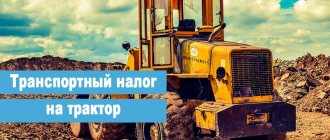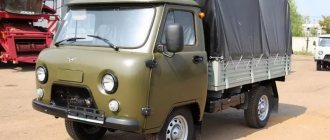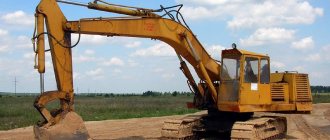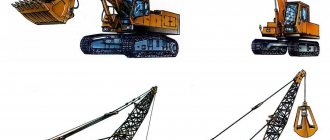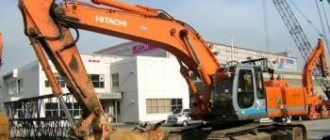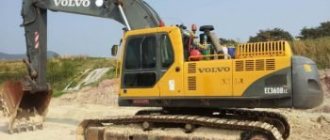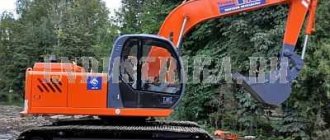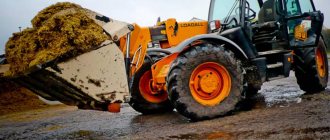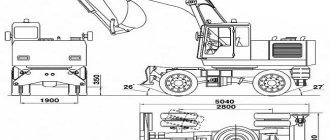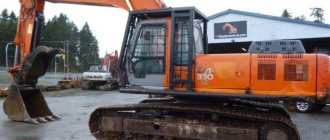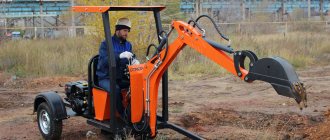Excavator:
Excavator
(from Latin excavo - “I dig, I take out”) - the main type of earth-moving machines equipped with a bucket. The main purpose is the development of soils (rocks, minerals) and loading of bulk materials.
An excavator is a self-propelled earth-moving machine, whether tracked, wheeled or walking, having an upper part capable of rotating 360°, with mounted working equipment designed primarily for digging with a bucket without moving the undercarriage during the working cycle.
The work cycle of an excavator includes digging, lifting, turning and unloading material. An excavator can also be used as a means to move products or materials.
Depending on the number of buckets installed on the excavator as a working tool, excavators are divided into single-bucket and multi-bucket excavators.
A single-bucket excavator is one of the types of excavators, and in fact - a self-propelled excavating and loading machine of cyclic action, whose function is to extract (excavate) soil (rocks, earth, rock masses, etc.), transport it over certain distances with subsequent loading or placement to the designated place.
The working component of the equipment - a single-bucket excavator - is a bucket with teeth, which differs depending on the type, type and model of the excavator in cubic volume parameters. The bucket is mounted on a boom, arm or ropes. Loading the bucket is carried out by moving the machine along the ground and excavating (digging) the soil with a bucket. In this case, the body of the machine relative to the surface of the earth during the excavation (digging) of soil and other operations of the main working cycle remains motionless, the traction force is created by the mechanisms of the excavator. When digging, the excavator is installed stationary and the digging operation is performed below ground level. This distinguishes an excavator from a scraper and a front-end loader, where the traction force when loading the bucket is created by moving the machine body.
A single-bucket excavator is the most common type of earth-moving machinery used in construction and mining.
Multi-bucket excavator is a continuous excavator with a bucket working tool. Buckets of a multi-bucket excavator are mounted on an endless chain (or chains), belt or rotor. The digging force is created by moving the buckets relative to the machine body. Compared to single-bucket excavators, they are characterized by greater productivity, but less versatility.
Multi-bucket excavators are used to perform large volumes of excavation work in road, reclamation and hydraulic engineering construction, for developing trenches when laying pipelines and cable lines, in military affairs for digging trenches, for mining, and when carrying out dredging work on reservoirs.
Bucket excavators are continuous excavators. They continuously develop and simultaneously transport soil to a dump or to a vehicle. Due to the combination of operations, multi-bucket excavators (as continuous excavators) differ from cyclic excavators (single-bucket excavators), which perform operations for the development, transportation and loading of soil sequentially in a certain order with multiple cyclic repetitions of the work cycle.
An excavator is a self-propelled machine or vehicle
Citizens who have a tractor driver (tractor driver) license issued by state authorities supervising the technical condition of self-propelled machines and other types of equipment in the Russian Federation (state technical supervision authorities) are allowed to operate self-propelled machines. The certificate has the following clearance categories.
In our opinion, this equipment cannot be classified as vehicles subject to transport tax for the following reasons. The introduction to the OKOF states that the subsection “Vehicles” includes vehicles intended for the movement of people and goods. The specified objects, by their purpose, are not vehicles transporting people and goods, but are used for production or household purposes. Is our position correct?
Interesting read: If a bailiff withdraws 50 from his salary, can he seize the car?
Types and types of excavators, classification of excavators:
There are many types and types of bucket excavators . They are classified according to the main parameter (operating weight with the main working equipment), by chassis type, by engine type, by transmission type, and other parameters.
Depending on the main parameter (operating weight with the main working equipment), single-bucket excavators are divided into the following size groups:
| Size group | Excavator weight, t | |
| Over | Before | |
| 1 | – | 6,3 |
| 2 | 6,3 | 10 |
| 3 | 10 | 18 |
| 4 | 18 | 32 |
| 5 | 32 | 50 |
| 6 | 50 | 71 |
by chassis type :
- mounted on tractors,
- car chassis,
- pneumatic,
- crawler,
- walking,
- railway,
- floating.
Based on the rotation of the working equipment relative to the supporting surface, single-bucket excavators are divided into full-rotary and part-rotary.
Based on the type of engine, single-bucket excavators are divided into electric, steam engine and internal combustion engine.
Depending on the type of working equipment, single-bucket excavators are divided into types:
- excavators with flexible suspension of working equipment,
- excavators with rigid suspension of working equipment.
Based on the direction of the bucket tooth, a distinction is made between single-bucket excavators with a front shovel and single-bucket excavators with a backhoe.
Based on the type of drive, single-bucket excavators are divided into excavators with mechanical, hydromechanical, hydraulic, electric and mixed drives.
Multi-bucket excavators , depending on the direction of movement of the cutting edge of the bucket in relation to the direction of movement of the machine, are divided into longitudinal, transverse and radial digging excavators.
Depending on the design of the working body, bucket excavators are divided into chain excavators and bucket wheel excavators.
Based on the type of running gear, multi-bucket excavators are divided into pneumatic-wheeled, crawler-mounted or combined.
An excavator is a self-propelled machine or vehicle
In the Russian Federation, in accordance with clause 2 of the Rules for admission to driving self-propelled machines and the issuance of tractor driver (tractor driver) certificates, approved by Decree of the Government of the Russian Federation of July 12, 2022 N 796 and taking into account Decree of the Government of the Russian Federation of May 6, 2022 N 351 “On amendments to the Rules for admission to driving self-propelled machines and issuing tractor driver (tractor driver) licenses” [1], officially understood as self-propelled machines.
Tags: Self-propelled machine photo, self-propelled machine is a vehicle, who invented the first self-propelled steam engine, who invented the first self-propelled steam engine 5 letters, self-propelled machine is, self-propelled grain cleaning machine class
.
Excavators mounted on tractors:
The lower support (base) of a single-bucket excavator mounted on a tractor is a classic tractor, in most cases a wheeled one.
Excavating equipment with incomplete rotation is installed on its rear part (in rare cases, on the side), which is attached to the base machine with a special frame. The excavator equipment of an excavator mounted on a tractor is a backhoe with a small-volume bucket - from 0.2 to 0.5 m3. The design of this type of excavator involves quick removal of working equipment - a bucket and its replacement with a grab (load-handling device), forks, a hook, and a hydraulic hammer.
Therefore, the use of such an excavator is advisable:
- for small-scale excavation work (repair of underground communications in public utilities, electrical and gas networks, etc.),
- for small-scale planning work (creating smooth, clean surfaces).
- for folding materials;
- for delivery and movement of goods;
- during construction and construction works.
The engine of the machine is the tractor-base motor with a hydraulic drive.
Excavators mounted on tractors are characterized by fairly high maneuverability and high speed of movement.
Excavators on a car chassis:
The base of single-bucket excavators on a car chassis is an off-road truck, which has the ability to move freely on any type of roads or in their absence (off-road). Trucks are capable of traveling long distances in a short time.
The scope of application of such an excavator: as a rule, for medium-scale earthmoving work (cleaning reservoirs, canals, construction and repair of road surfaces, highways, etc.), and when changing working equipment (from a bucket to another) - also for construction and construction work. work, warehousing, delivery and movement of goods.
The main working equipment in most cases is a backhoe with a bucket with a volume of 0.04 to 1.5 m3. Less common are models where there is a transition from a straight shovel to a backhoe due to the presence of a rotating bucket and a telescopic boom. Some models can be equipped with replaceable working equipment: grab, load forks, hook, hydraulic hammer.
The following motors can act as propulsion machines:
- directly to the base vehicle;
- separate motors mounted on a turntable.
Pneumatic wheeled excavators:
Pneumatic single-bucket excavators have their own chassis, which rests on wheels equipped with pneumatic tires.
pneumatic wheeled excavators are characterized by full rotation and are equipped with outriggers designed to prevent the machine from tipping over and sliding when loading the bucket.
They are capable of reaching independent speeds of up to 30 km/h, and when towed by trucks – up to 40 km/h, but they move more slowly on soft soils.
Pneumatic wheeled excavators are produced in various sizes and can have a bucket volume from 0.04 to 1.5 m3 or more. The working equipment is a front or backhoe, a grab, a jaw grip, and a hydraulic hammer.
The main work performed by a pneumatic wheeled excavator :
- medium-scale earthmoving work (development of pits and trenches, loosening the soil, etc.);
- medium-scale planning work;
- construction and construction works;
- storage of materials;
- delivery and movement of goods.
Crawler excavators:
Crawler single-bucket excavators are equipped with a specialized chassis that includes a caterpillar drive in the design.
Crawler excavators are manufactured exclusively with full rotation.
Their distinctive features: increased maneuverability and low specific pressure on the surface with a fairly large weight of the equipment. They are suitable for developing peat and performing tasks on waterlogged soils.
Crawler excavators have a low speed, which does not exceed 15 km/h, so they are delivered to the work site by tractors or on special trailers.
The advantages of crawler excavators include a wide bucket configuration - their volumes vary from very small (0.04 m3) to huge (26 m3).
The list of working equipment for such an excavator is quite wide: a front shovel, a backhoe, a dragline (a single-bucket excavator with cable-block equipment), a grab, a jaw gripper, and a hydraulic hammer for loosening the soil.
The main work performed by a crawler excavator is similar to that of a pneumatic wheeled excavator:
- earthmoving work of medium and large scale (development of pits and trenches, loosening the soil, etc.);
- medium-scale planning work;
- construction and construction works;
- storage of materials;
- delivery and movement of goods.
Crawler excavators are used primarily in the mining and construction industries.
An excavator is a self-propelled machine or vehicle
If the vehicle is not operated on public roads and is registered with Gostekhnadzor, then the tax rate is applied for the category “other self-propelled vehicles” (Letters of the Ministry of Finance of Russia dated May 31, 2022 N 03-06-04-04/21 and the Federal Tax Service of Russia dated July 6, 2022 N 18-0-09/0204).
There are vehicles that are not intended for use on public roads. These include, for example, excavators, scrapers, dump trucks and other mining equipment. These vehicles are considered to be self-propelled. And, accordingly, lower tax rates apply to them than to freight transport. But tax authorities do not always agree with this. They are trying to classify them as freight transport, which will significantly affect the amount of tax.
Walking excavators:
A walking excavator is a rotating platform on a base plate with the working equipment of a walking excavator installed on it.
Additionally, the platform is equipped with paws that ensure the movement of equipment, which during operation are in a raised position (do not rest on the surface of the ground). The movement itself is carried out by lifting the base plate from the ground by lowering the paws to the ground, which is a step of the machine (mostly forward, but in some models there is also a reverse move), after which the paw is raised and returned to its original position for subsequent lowering (stroke). ). After which the cycle of movement of the walking single-bucket excavator is repeated again.
Walking excavators are usually equipped with fairly large buckets - from 15 to 40 m3, the boom reach can range from 65-150 m.
Only a dragline is used as working equipment.
Walking type excavators are used :
- during stripping operations (removal of waste rock from mineral deposits);
- when developing the subsoil of the earth and minerals;
- when moving mined minerals.
Transport tax in the regions
According to Art. 361 of the Tax Code of the Russian Federation, the base rate for this category is set at 2.5 rubles. with one hp However, the Tax Code enshrines the right of regions to increase the base rate by up to 10 times.
Let us now tell you how the subjects disposed of their rights.
- In Moscow, you will have to pay 25 rubles for each horsepower of an excavator. (MSK law No. 33 of 07/09/08). In this case, organizations are required to pay tax to the budget in full (advance payments have been abolished since 2015) before February 5 of the year following the reporting year.
- The same rate (25 rubles/hp) is established in St. Petersburg (law No. 487-53 of November 4, 2002), Moscow (law No. 129/2002-OZ of November 16, 2002), Leningrad ( law No. 51-OZ of November 22, 2002) and the Nizhny Novgorod regions (regional law No. 71-Z of November 28, 2002).
- In the Krasnoyarsk Territory - for every hp. excavator capacity will be charged 11.5 rubles. tax In Saratov, horsepower costs 21 rubles. In Sverdlovsk - 16 rubles, in Omsk - 12 rubles, in Bashkortostan - 20 rubles.
- The lowest vehicle tax rate is in the third city of federal significance - Sevastopol. Let us remind you that in the current 2015, Crimean taxpayers will pay transport tax for the first time. The rate for excavators here is 5 rubles/hp. (city law No. 75-ZS dated November 14, 2014). By the way, this record low rate is the same for the entire Republic of Crimea (Law No. 8-ZRK/2014 of November 19, 2014).
Please note: in some regions, organizations have transport tax benefits. For example, in St. Petersburg, organizations registered in a special economic zone are exempt from paying taxes on excavators and other vehicles for 5 years.
If a taxpayer enterprise has the right to preferential payment of tax, it must submit documents confirming this right within the period established by law (as a rule, this must be done before the end of the tax period). Those who do not have time to submit documents will not be able to take advantage of the benefit until the next tax period.
The benefit is provided for a period not exceeding the validity period of the title documents, including indefinitely.
Full rotation excavators:
For full-rotary excavators , the working equipment, drives, driver's cabin and engine are installed on a rotating platform, which, in turn, is mounted on the chassis by means of a rotary support device (SDU), and can be rotated relative to it in any direction at any angle. Parts of the hydraulic system of the chassis and rotating platform of full-rotary excavators are connected using a manifold, which allows an unlimited number of full revolutions in one direction.
Partial rotation excavators:
For semi-rotary excavators, the working equipment is attached to the chassis using a rotating column, the installation of which involves the presence of transverse guides. As a result, the column can be moved along with the working equipment to the right and/or left side with further rigid fixation, which ensures ease of use and durability of the equipment. The rotation angle is limited and ranges from 45-90 degrees. The remaining components of the structure - the cabin, engine and other mechanisms - are mounted on a fixed chassis.
Currently, tractor-mounted excavators are mainly produced as semi-rotary ones.
Excavators with internal combustion engine:
An excavator with an internal combustion engine is equipped with its own internal combustion engine, most often running on diesel fuel, which allows the excavator to operate autonomously.
The torque-speed characteristics of the engine and working equipment of a single-bucket excavator with an internal combustion engine are not consistent, which necessitates the use of matching gears, which are:
- gearboxes;
- torque converters;
- hydraulic transmissions.
The first two types of equipment are typical for mechanical machines, the last - for hydraulic ones.
Almost all types of these machines are equipped with one engine, the only exception being heavy excavators for quarry work, which may include two engines. In this case, there are such designs of technology:
- both engines are placed on a turntable;
- one of the engines is located on a tracked chassis and is used exclusively for moving the excavator itself, and the second is on a turntable.
Categories of self-propelled vehicles
The practice is completed in two stages. The first part is rented out on a site closed from traffic, which is characterized as a tractor track. The second part is carried out on a pre-selected route, which creates real operating conditions for a self-propelled vehicle.
- Complete specialized training and receive professional basic or additional education. Programs are being studied that are directly or indirectly related to the management of self-propelled vehicles of the listed categories. After completing the courses, you will receive a corresponding document confirming the assigned qualification.
- Pass a special medical examination to obtain a medical certificate. The document must confirm the complete absence of medical contraindications for driving self-propelled vehicles.
